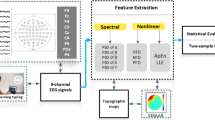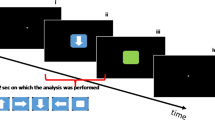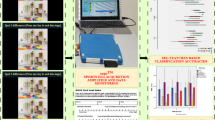Abstract
Generally, the training evaluation methods consist in experts supervision and qualitative check of the operator’s skills improvement by asking them to perform specific tasks and by verifying the final performance. The aim of this work is to find out if it is possible to obtain quantitative information about the degree of the learning process throughout the training period by analyzing neuro-physiological signals, such as the electroencephalogram, the electrocardiogram and the electrooculogram. In fact, it is well known that such signals correlate with a variety of cognitive processes, e.g. attention, information processing, and working memory. A group of 10 subjects have been asked to train daily with the NASA multi-attribute-task-battery. During such training period the neuro-physiological, behavioral and subjective data have been collected. In particular, the neuro-physiological signals have been recorded on the first (T1), on the third (T3) and on the last training day (T5), while the behavioral and subjective data have been collected every day. Finally, all these data have been compared for a complete overview of the learning process and its relations with the neuro-physiological parameters. It has been shown how the integration of brain activity, in the theta and alpha frequency bands, with the autonomic parameters of heart rate and eyeblink rate could be used as metric for the evaluation of the learning progress, as well as the final training level reached by the subjects, in terms of request of cognitive resources.












Similar content being viewed by others
References
Anderson JR (1993) Rules of the mind. Psychology Press, New York, p 320
Astolfi L, Cincotti F, Mattia D, Marciani MG, Baccalà LA, De Vico Fallani F, Salinari S, Ursino M, Zavaglia M, Babiloni F (2006) Assessing cortical functional connectivity by partial directed coherence: simulations and application to real data. IEEE Trans Biomed Eng 53:1802–1812
Astolfi L, De Vico Fallani F, Cincotti F, Mattia D, Marciani MG, Bufalari S, Salinari S, Colosimo A, Ding L, Edgar JC, Heller W, Miller GA, He B, Babiloni F (2007) Imaging functional brain connectivity patterns from high-resolution EEG and fMRI via graph theory. Psychophysiology 44:880–893
Babiloni F, Cincotti F, Babiloni C, Carducci F, Mattia D, Astolfi L, Basilisco A, Rossini PM, Ding L, Ni Y, Cheng J, Christine K, Sweeney J, He B (2005) Estimation of the cortical functional connectivity with the multimodal integration of high-resolution EEG and fMRI data by directed transfer function. NeuroImage 24:118–131
Barachant A, Andreev A, Congedo M (2013a) The Riemannian potato: an automatic and adaptive artifact detection method for online experiments using Riemannian geometry. In: Proceedings of TOBI Workshop IV, Sion, Suisse, pp 19–20
Barachant A, Bonnet S, Congedo M, Jutten C (2013b) Classification of covariance matrices using a Riemannian-based kernel for BCI applications. Neurocomputing 112:172–178
Berka C (2011): Exploring subjective experience during simulated reality training with psychophysiological metrics. Marine Corp Warfighting Laboratory Workshop. Physiological metrics of immersion. Advanced Brain Monitoring, Inc., p 12
Berka C, Levendowski DJ, Lumicao MN, Yau A, Davis G, Zivkovic VT, Olmstead RE, Tremoulet PD, Craven PL (2007) EEG correlates of task engagement and mental workload in vigilance, learning, and memory tasks. Aviat Space Environ Med 78(5):231–244
Borghini G, Isabella R, Vecchiato G, Toppi J, Astolfi L, Caltagirone C, Babiloni F (2012) A Flight history from a cognitive point of view: novices versus experts. Ital J Aerosp Med 5:34–47
Borghini G, Astolfi L, Vecchiato G, Mattia D, Babiloni F (2014) Measuring neurophysiological signals in aircraft pilots and car drivers for the assessment of mental workload, fatigue and drowsiness. Neurosci Biobehav Rev 44:58–75
Brodmann K (2006) Localisation in the cerebral cortex. Springer, New York, p 150
Comstock JR, Arnegard RJ (1992) Matb—multi-attribute task battery for human operator workload and strategic behavior research. NASA Technical Memorandum 104174. p 114
Ding L, Lai Y, He B (2005) Low resolution brain electromagnetic tomography in a realistic geometry head model: a simulation study. Phys Med Biol 50:45–56
Doppelmayr M, Finkenzeller T, Sauseng P (2008) Frontal midline theta in the pre-shot phase of rifle shooting: differences between experts and novices. Neuropsychologia 46:1463–1467
Elliot AJ, Payen V, Brisswalter J, Cury F, Thayer JF (2011) A subtle threat cue, heart rate variability, and cognitive performance. Psychophysiology 48:1340–1345
Fielder J (2010) Electroencephalogram (EEG) study of learning effects across addition problems. PEBL Technical Report Series. http://www.quasarusa.com/pdf/Fielder_2010_EEG%20Study%20of%20Learning%20Effects%20across%20Addition%20Problems.pdf
Fukuda K (2001) Eye blinks: new indices for the detection of deception. Int J Psychophysiol Off J Int Organ Psychophysiol 40:239–245
Galán FC, Beal CR (2012) EEG estimates of engagement and cognitive workload predict math problem solving outcomes. In: Masthoff J, Mobasher B, Desmarais MC, Nkambou R (eds) User modeling, adaptation, and personalization., Lecture notes in computer scienceSpringer, Heidelberg, pp 51–62
Grave de Peralta Menendez R, Andino SG (1999) Distributed source models: standard solutions and new developments. In: Uhl C (ed) Analysis of neurophysiological brain functioning. Springer, Heidelberg, pp 176–201
Hansen PC (1992) Analysis of discrete Ill-posed problems by means of the L-curve. SIAM Rev 34:561–580
Hart SG, Staveland LE (1988) Development of NASA-TLX (task load index): results of empirical and theoretical research. In: Hancock PA, Najmedin Meshkati (eds) Advances in psychology, human mental workload. Elsevier, North-Holland, pp 139–183
He B, Hori J, Babiloni F (2006) Electroencephalography (EEG): inverse problems. In: Wiley encyclopedia of biomedical engineering. John Wiley & Sons, Inc. doi:10.1002/9780471740360.ebs0655
Hyvärinen A, Oja E (2000) Independent component analysis: algorithms and applications. Neural Netw 13:411–430
Jaušovec N, Jaušovec K (2012) Working memory training: improving intelligence—changing brain activity. Brain Cognit 79:96–106
Kalyuga S, Ayres P, Chandler P, Sweller J (2003) The expertise reversal effect. Educ Psychol 38:23–31
Kandel E, Schwartz J, Jessell T (2000) Principles of neural science, 4th edn. McGraw-Hill Companies, New York, p 1414
Kelly SP, Dockree P, Reilly RB, Robertson IH (2003) EEG alpha power and coherence time courses in a sustained attention task. In: First international IEEE EMBS conference on Neural Engineering, 2003. Conference Proceedings, pp 83–86
Klimesch W (1999) EEG alpha and theta oscillations reflect cognitive and memory performance: a review and analysis. Brain Res Brain Res Rev 29:169–195
Klimesch W (2012) Alpha-band oscillations, attention, and controlled access to stored information. Trends Cognit Sci 16:606–617
Klimesch W, Doppelmayr M, Russegger H, Pachinger T, Schwaiger J (1998) Induced alpha band power changes in the human EEG and attention. Neurosci Lett 244:73–76
Kotovsky K, Hayes JR, Simon HA (1985) Why are some problems hard? Evidence from Tower of Hanoi. Cognit Psychol 17:248–294
Lal SKL, Craig A (2002) Driver fatigue: electroencephalograpy and psychological assessment. Psychophysiology 39:313–321
Logan GD (1988) Toward an instance theory of automatization. Psychol Rev 95:492–527
Luu P, Tucker DM (2001) Regulating action: alternating activation of midline frontal and motor cortical networks. Clin Neurophysiol 112:1295–1306
Mackie MA, Van Dam NT, Fan J (2013) Cognitive control and attentional functions. Brain Cognit 82:301–312
Nunez PL (1995) Neocortical dynamics and human EEG rhythms. Oxford University Press, New York
Palomba D, Angrilli A, Mini A (1997) Visual evoked potentials, heart rate responses and memory to emotional pictorial stimuli. Int J Psychophysiol Off J Int Organ Psychophysiol 27:55–67
Prinzel LJ, Freeman FG, Scerbo MW, Mikulka PJ, Pope AT (2003) Effects of a psychophysiological system for adaptive automation on performance, workload, and the event-related potential P300 component. Hum Factors J Hum Factors Ergon Soc 45:601–614
Ridderinkhof KR, van den Wildenberg WPM, Segalowitz SJ, Carter CS (2004) Neurocognitive mechanisms of cognitive control: the role of prefrontal cortex in action selection, response inhibition, performance monitoring, and reward-based learning. Brain Cognit 56:129–140
Rihs TA, Michel CM, Thut G (2007) Mechanisms of selective inhibition in visual spatial attention are indexed by α-band EEG synchronization. Eur J Neurosci 25:603–610
Ritter F, Schooler L (2001) The learning curve. In: International encyclopedia of the social & behavioral sciences, Elsevier Science Ltd, p 1508
Rosenbloom PS, Laird JE, Newell A (1993) The soar papers: research on integrated intelligence, vol 1. MIT Press, Cambridge, MA
Sadaghiani S, Scheeringa R, Lehongre K, Morillon B, Giraud AL, Kleinschmidt A (2010) Intrinsic connectivity networks, alpha oscillations, and tonic alertness: a simultaneous electroencephalography/functional magnetic resonance imaging study. J Neurosci Off J Soc Neurosci 30:10243–10250
Schneider W, Shiffrin RM (1977) Controlled and automatic human information processing: I. Detection, search, and attention. Psychol Rev 84:1–66
Shiffrin RM, Schneider W (1977) Controlled and automatic human information processing: II. Perceptual learning, automatic attending and a general theory. Psychol Rev 84:127–190
Shultz S, Klin A, Jones W (2011) Inhibition of eye blinking reveals subjective perceptions of stimulus salience. Proc Natl Acad Sci USA 108:21270–21275
Smith ME, Gevins A, Brown H, Karnik A, Du R (2001) Monitoring task loading with multivariate EEG measures during complex forms of human-computer interaction. Hum Factors J Hum Factors Ergon Soc 43:366–380
Strimmer K (2008) A unified approach to false discovery rate estimation. BMC Bioinform 9:303
Sweller J (1999) Instructional design in technical areas. Australian Council for Educational, Camberwell
Sweller J, van Merrienboer JG, Paas FGWC (1998) Cognitive architecture and instructional design. Educ Psychol Rev 10:251–296
Trejo LJ, Shensa MJ (1999) Feature extraction of event-related potentials using wavelets: an application to human performance monitoring. Brain Lang 66:89–107
Wilson GF, Russell CA (2003) Real-time assessment of mental workload using psychophysiological measures and artificial neural networks. Hum Factors J Hum Factors Ergon Soc 45:635–644
Zar JH (1999) Biostatistical analysis. Prentice Hall PTR, New Jersey
Acknowledgments
This work is co-financed by EUROCONTROL on behalf of the SESAR Joint Undertaking in the context of SESAR Work Package E - NINA research project. The paper reflects only the authors’ views. EUROCONTROL is not liable for any use that may be made of the information contained therein. The work is also partially supported by the Regione Lazio, through FILAS spa, in the context of the project BrainTrained, CUP: F87I12002500007.
Author information
Authors and Affiliations
Corresponding author
Additional information
Gianluca Borghini and Pietro Aricò contributed equally to this work.
Appendix: Estimation of Cortical Source Current Density
Appendix: Estimation of Cortical Source Current Density
Cortical activity has been estimated from EEG scalp recordings by employing the high-resolution EEG technologies (Astolfi et al. 2006, 2007) with the use of the average head model from McGill University (Ding et al. 2005). Electrode positions over the scalp have been obtained individually for each subject by using the Photomodeler software (Eos System Inc). The cortical model consisted of about 8,000 dipoles uniformly disposed on the cortical surface. The estimation of the current density strength for each dipole has been obtained by solving the electromagnetic linear inverse problem (He et al. 2006; Nunez 1995). In particular, the solution of the linear system,
at a particular time instant t provides an estimation of the dipole source configuration x at time t that generates the measured EEG potential distribution b in the same instant. The system also includes the measurement noise n, assumed to be normally distributed. A is the lead field matrix, where each j-th column describes the potential distribution generated on the scalp electrodes by the j-th unitary dipole. The current density solution vector ξ of Eq. (2) has been obtained as (Babiloni et al. 2005; Grave de Peralta Menendez and Andino 1999):
where M, N are the matrices associated to the metrics of the data and of the source space, respectively, ξ is the regularization parameter and ||x||M represents the M norm of the vector x. The solution of Eq. (3) is given by the inverse operator G:
The optimal determination of the regularization term (ξ) of this linear system has been obtained by the L-curve approach (Hansen 1992; He et al. 2006). As a metric in the data space, the identity matrix has been used, while as a norm in the source space, the following metric was adopted:
where (N −1)ii is the i-th element of the inverse of the diagonal matrix N and all the other matrix elements Nij are set to 0. The L2 norm of the i-th column of the lead field matrix A is denoted by ||A .i ||. Using the relations described above, an estimation of the signed magnitude of the dipolar moment for each cortical dipoles has been obtained for each time point. As the orientation of the dipole has been defined to be perpendicular to the local cortical surface in the head model, the estimation process returned a scalar rather than a vector field. The spatial average of the signed magnitude, of all the dipoles belonging to a particular ROI at each time sample, was used to estimate the waveforms of cortical ROI activity in that ROI, indicated as ρ(t) to highlight their time-dependence. Spatial averaging can be expressed in terms of matrix multiplication by a matrix T. This matrix is sparse and has as many rows as ROIs, and as many columns as the number of dipole sources. ROI cortical current density waveforms can then be expressed as:
where b(t) is the array of the waveforms recorded from the scalp electrodes and x(t) is the array of the cortical current density waveforms estimated at the cortical surface. The G ROI matrix only depends on geometrical factors, and can thus be computed and stored off-line. The matrix multiplication can be interpreted as a spatial filtering of the scalp potential b(t), using the elements of G ROI as weights. In this way, we could obtain time-varying waveforms at the level of different cortical areas. In the next paragraph, such cortical areas will be described as coincident with particular Brodmann areas for all the subjects involved in the present study.
Rights and permissions
About this article
Cite this article
Borghini, G., Aricò, P., Graziani, I. et al. Quantitative Assessment of the Training Improvement in a Motor-Cognitive Task by Using EEG, ECG and EOG Signals. Brain Topogr 29, 149–161 (2016). https://doi.org/10.1007/s10548-015-0425-7
Received:
Accepted:
Published:
Issue Date:
DOI: https://doi.org/10.1007/s10548-015-0425-7




